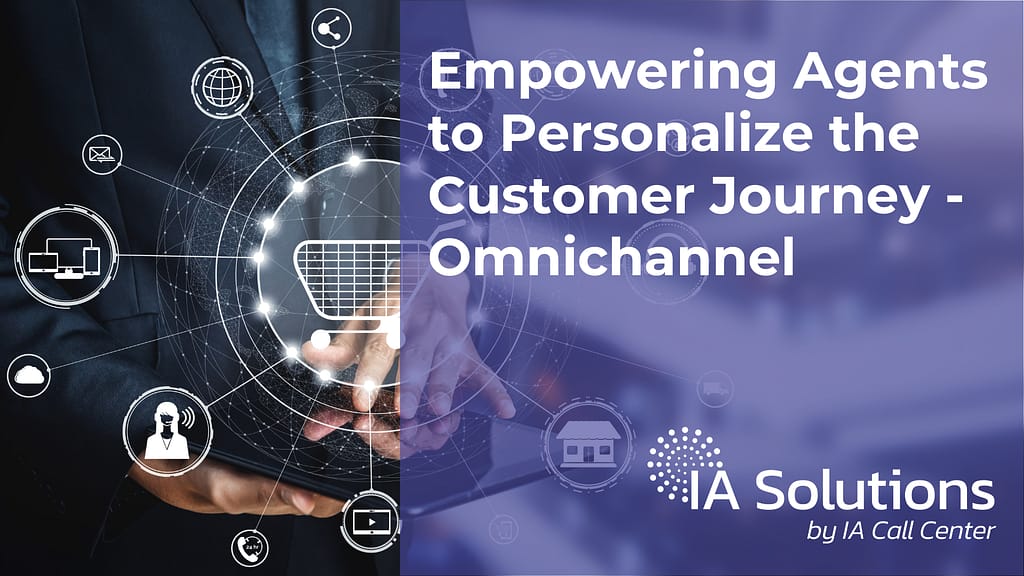Rather listen to this post instead? Click play to hear it now.
Note – This is the second post in our series, “Empowering Agents to Personalize the Customer Journey.” If you missed the first one, “Defining Goals,” please click here to view it now. We are releasing new posts for this series every week. Therefore, please be sure to enable notifications to receive updates when we post new articles.)
Introduction
In today’s super-competitive business environment, you need to capitalize on any advantage you can find to thrive and grow. One way of getting a leg up on competitors is by providing your customers a seamless and personalized experience across all touchpoints they might use to contact your business. In fact, providing this “omnichannel” access has become a crucial aspect of achieving success for many companies.
To achieve this type of omnichannel flexibility, you should provide a wide range of channels your customers can use to engage with your team. Additionally, you must equip your agents with the tools and knowledge necessary to personalize customer journeys across these multiple channels.
When you offer sufficient omnichannel choices, customers can choose how they contact your CX team in the manner most convenient for them, which increases satisfaction not only for your customers, but for your CX team or contact center agents as well.
Why Omnichannel Access is Important to Customers
There are several important reasons to provide your customers with omnichannel access to your CX or support teams. So, let’s discuss a few. First, omnichannel gives your customers the freedom to choose the channel that best suits their individual needs and preferences. For instance, some of your customers may prefer to use live chat for quick and efficient communications and resolutions. On the other hand, some customers may prefer the more personal touch phone calls or video conferencing may provide.
Another reason to use omnichannel is that it allows customers to engage with your brand anytime, from any device, and from virtually anywhere. This, of course, offers customers much more convenience and flexibility than traditional call centers or email support teams.
Need yet another important reason to provide omnichannel access? Well, omnichannel access also allows customers to move seamlessly between channels, which ensures continuity of conversations and reduces the need to repeat or reenter information.
An article by the International Journal of Research details the importance of providing omnichannel access to customers. In the article, they write that customers who engage with brands through multiple channels provide companies with a 30% higher lifetime value than those who engage through just one channel. Additionally, research by Radicati Group shows that customers who engage with a brand through multiple channels are much more likely to recommend that business to others.

The Advantages of Omnichannel Support for Companies
Offering your customers omnichannel support not only improves their experiences considerably but also impacts your business outcomes significantly. Take, for instance, an article from Harvard Business Review that shows businesses that provide omnichannel support typically experience at least a 20% increase in customer satisfaction and an impressive 15% increase in revenue. Additionally, a report from Gartner states companies that provide omnichannel customer service boast a 15% increase in established customer loyalty.
Research by Mitto also supports the advantages omnichannel services offer companies. Mitto found that companies that provide omnichannel support get a boost of about 10% in annual revenue per customer, as opposed to those that provide only single-channel support. Furthermore, reports from sources such as Sprout Social and Forbes show that omnichannel support services help businesses enjoy up to a 91% customer retention rate, compared to 33% for those companies that, again, provide support via a single channel.
Unified Tools to Personalize the Customer Journey
While providing omnichannel choices can help ensure personalized experiences for customers, implementation can be a daunting task for some companies. One way to make integrations a bit easier is to empower agents with unified tools and access to knowledge they need to assist customer across channels. Providing agents with access to a unified customer view, a knowledge management system, and other relevant software tools makes it easier for them to manage and monitor multiple channels simultaneously.
Additionally, these tools make it much easier for agents to communicate and engage with customers across all the channels your team uses. For instance, these tools can help agents and supervisors track customer engagement data, such as interactions, response times, and customer satisfaction, and also help analyze that data to identify trends and areas for improvement.
Let’s look at an example: A leading software company implements an omnichannel customer engagement platform that allows their agents to monitor and respond to customer inquiries and feedback across all channels in real-time. These channels include phone, email, live chat, social media, web forms, and videoconferencing.
The company also uses a set of unified tools that enables them to manage and monitor the channels and allows them to quickly identify and resolve issues, improve response times, and increase customer satisfaction. Furthermore, offering more touchpoints and choices helps the software company foster more loyalty (and word-of-mouth referrals) from their customers.
Channels for Customer Engagement
Each channel in an omnichannel environment has its own advantages and disadvantages, and it is essential to understand these to provide the best customer experiences. With that in mind, let’s take a look at channels typically used in an omnichannel setup. We will also discuss some reasons customers may or may not to choose each type of channel.
Phone
Traditional phone conversations between agents and customers offer a personal touch and allow for real-time communication and assistance. Phone calls are usually much more suitable for complex issues and generally provide more trust and confidence for customers than other channels. Nevertheless, on the negative side, phone calls can be time-consuming and may not be preferred by all customers.
Email interactions offer customers and CX departments a written record of conversations and allow for asynchronous communication. Typically, email is suitable for less urgent issues and can provide a sense of convenience for the customer, as they can send or respond to emails any time they choose. However, email interactions are often viewed as less personal and may not be the best option for more complex issues.
Live Chat
Live chat offers customers a quick, convenient, and efficient method of contacting your support team to resolve issues through real-time messaging. Generally speaking, live chat is suitable for simple and urgent issues and gives customers a sense of convenience and personal dedication by your CX team. However, live chat interactions may not always be suitable for complex issues and some customers may not feel that “personal touch” if agents use obvious canned responses or show little interest during conversations.
Social Media
Social media interactions (such as responding to direct messages, customer posts, tags, etc.) enable a tremendously wide reach and can provide a sense of community for customers. Popular social media channels are excellent for addressing customer complaints and feedback and can demonstrate transparency to your community. Still, social media interactions may not be appropriate for all issues, as they do indeed require a delicate, pragmatic approach.
Social media interactions are, by their very nature, visible to countless other customers and would-be customers, and missteps when using these channels can have disastrous results. Therefore, particular care and caution must be exercised in their management.
Web Forms
Web forms on your company website allow customers to easily provide feedback or report issues at their convenience. Not only are web forms easy and convenient for customers to use, they are also cheap and simple to implement. In terms of ROI, web forms offer a great deal of value, as most customers already are aware of the forms and know how to use them. Nonetheless, web forms may not be suitable for more complicated or complex issues and rarely provide a personalized touch.
Video Conferencing
Video conferencing offers the personal touch of phone conversations and has the added benefit of face-to-face communication, which is almost like being there in person. Additionally, video conferencing sessions are excellent for complex or difficult issues and help tremendously in conveying a sense of trust and confidence for customers. However, videoconferencing may not be available for customers in remote locations or areas with limited internet access. Moreover, videoconferencing can be expensive to set up and maintain for businesses without solid connectivity and technical infrastructure.
In-Person
For truly personalized service, nothing beats in-person interactions. In-person engagement offers a truly personal touch and builds trust and confidence with customers more than any other support method, medium, or channel. In-person engagements are suitable for virtually all situations and issues. Many companies overlook in-person customer engagements these days. However, for resolving tough issues or establishing/reestablishing bonds or relationships with customers, no other channel is more effective.
In-person interactions are not possible for all businesses and/or customers. Still, if they are an option for your business, don’t take them for granted; and be sure to allocate your best people and adequate resources to supporting them. Winning customers over face-to-face takes skill and patience, but – when successful — no method produces better results.
Other Tools to Consider
While implementing omnichannel access is an excellent way to engage with customers on more personalized levels and provide them with a wider range of connection choices, there are a couple more tools your business should consider that help tie all those channels together.
API Options
APIs allow companies to integrate their omnichannel systems and services with other platforms and tools quickly and efficiently using relatively easy-to-implement software code. With APIs, your CX developers or IT staff can automate processes, streamline data transfers, and increase the efficiency of your customer engagement efforts. APIs are incredibly powerful and are useful for virtually every touchpoint or channel. The one downside with APIs, though, is that implementing them may require significant investment and technical expertise.
Cloud-Based Telephony
In a general sense, cloud-based telephony is the highly available and very reliable technology that allows companies to make and receive phone calls over the Internet. And while this is certainly the most common use of the technology, cloud-based telephony is also essential to connecting omnichannel services and touchpoints.
Cloud-based telephony is the backbone of omnichannel services and enables companies to reduce operational costs, increase scalability, and improve communication quality. Cloud-based phone systems are also central to the management and monitoring systems needed to make omnichannel operations possible.
Finally, cloud-based telephony is easier and cheaper to implement than traditional landline-based phone systems and offers much more in terms of flexibility, scalability, security, and upgradeability. Really, the only possible pitfall with cloud-based phone systems is that their installation and use may not be possible in areas that lack stable Internet infrastructure.

Training Agents to Use Omnichannel Tools
By now, you understand the significant advantages omnichannel tools can provide your business in improving and personalizing customer experiences. However, to use these tools and channels to their full potential, it is crucial that you train your agents on how to best use them.
This training needs to include instruction on the use of software tools and systems, as well as on best practices in how to handle customer communications via the various channels. Agents should also learn how to access and use a unified customer view. Also, consider using an effective knowledge management system, and training on how to monitor and engage with customers across all channels your team supports. Additionally, your IT team or tech services vendor needs to be up to speed on API options and cloud-based telephony integration.
Some additional ideas for training agents in using omnichannel tools include:
- Providing agents online tutorials and training materials;
- Offering agents hands-on training sessions;
- Providing agents ongoing support and resources;
- Allowing agents to practice and test the tools in simulated environments;
- Encouraging agents to share experiences and best practices with peers.

Planning and Setting Smart Goals to Personalize Customer Journeys
In the first article of this series, we focused on defining goals and strategies to use omnichannel tools to empower agents to personalize customer journeys. However, just in case you missed that post, we will outline briefly some of the more important points covered in that post.
Before you implement omnichannel tools, it is important to plan and set smart goals. These goals should include identifying the channels that you will use, determining the customer segments you want to target, and setting specific and measurable goals for customer engagement and satisfaction. When defining your goals, remember to be S.M.A.R.T.
- Specific: Your goals all clearly state what is to be achieved or what the desired result is;
- Measurable: Your goals include measurable indicators to track progress;
- Actionable: Your goals include clear direction on the steps needed to achieve them;
- Realistic: Your goals are something that can actually be achieved;
- Time Bound: Your goals include a fairly aggressive deadline to achieve them.
When defining and setting goals, it is also important to clearly understand the resources and budget required to implement and maintain your company’s omnichannel tools. By developing a well thought out plan and setting clear goals, you can ensure that your efforts are focused, effective, and lead to improved customer engagement and business outcomes.
We encourage you to learn more about defining and setting goals for personalizing customer journeys. To do so, please click here to view our post, “Empowering Agents to Personalize the Customer Journey- Defining Your Goals.”
Conclusion
As mentioned above, giving your customers omnichannel choices and empowering your agents to personalize customer journeys with omnichannel is essential to providing seamless, personalized experiences. Also, integrating omnichannel tools with API options and cloud-based telephony can help to make implementing and managing those tools easier and more effective.
By giving agents access to a unified customer view, an easy-to-use knowledge management system, and software systems that make it easier to manage and monitor multiple channels simultaneously, your company can ensure that agents have the information they need to personalize customer journeys (on every channel.) These tools can help provide more effective agent-customer interactions, which increases customer satisfaction, loyalty, and revenue.
Provide your agents with the training needed to use omnichannel tools properly. Also, have a well-planned approach with smart goals to ensure their successful implementation and management. Finally, your company should take a comprehensive approach to omnichannel support. By doing so, not only can you improve customer experiences; you will also foster greater agent satisfaction and drive business growth.
In the next post of our Empowering Agents to Personalize the Customer Journey series, we will discuss the best types of tools to use when implementing or shifting to omnichannel support. If you want to find out more about how and which omnichannel tools can help your company better personalize customer experiences, be sure to check back a few days after this post.















